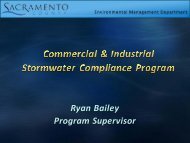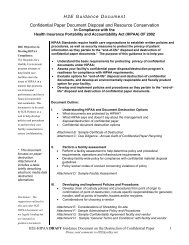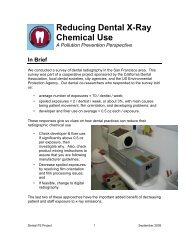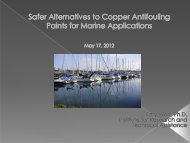marine tourism best management practices a practical guide
marine tourism best management practices a practical guide
marine tourism best management practices a practical guide
You also want an ePaper? Increase the reach of your titles
YUMPU automatically turns print PDFs into web optimized ePapers that Google loves.
Marine Tourism Best Management PracticesPeople For Puget Sound • pugetsound.org2. Bilge Water Management:• Bilge water shall not be discharged• Prevent oil contamination of bilge water: (a) do not drain oil into the bilge;(b) use containment troughs underneath the engine to capture drips orspills; (c) use oil absorbent pads, socks or pillows to soak up oil and fuel;(d) fix leaks as they occur; (e) inspect fuel lines and hoses for chaffing, wearand general deterioration; (g) clean bilge areas after engine maintenance• Keep engines tuned and minimize engine cleaners and detergents• Dispose of oil soaked absorbents when liquids are fully absorbed3. Ballast Water Management:• Pre-arrival ballast exchange is required prior to discharge into Washingtonwaters• Perform open sea exchange in 2,000 meters or more and if not possible,50 nautical miles offshore• The state of Washington requires at least 24 hours prior to enteringWashington water, using the approved U.S.Coast Guard Ballast Reportingform (forms submitted to waballast@aol.com or faxed to (206) 443-8025).If not discharging, the form should be filled out “not discharging” in thehistory part of Section 1.4. Used Oil:• Used oil must be removed by a used oil service provider5. Hazardous Chemicals, Cleaners and Wastes Management:• Cover and contain hazardous or flammable chemical materials on the vessel,gas cylinders and batteries and do not store at Terminal 30 or Pier 66• Used oil, antifreeze, paints, solvents, varnishes, gas cylinders, preservativesand batteries must be disposed through a hazardous waste disposalcontractor• Clear and contain any debris, trash, sanding dust, paint chips, slag etc fromwork areas immediately after any maintenance or repair activity and disposeof properly6. Spill Prevention and Response:• Sufficient absorbent materials and spill containment instruments to confinea spill should be carried aboard the vessel24








![Dental Amalgam Use [pdf]](https://img.yumpu.com/33828185/1/190x245/dental-amalgam-use-pdf.jpg?quality=85)




